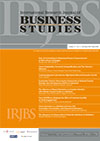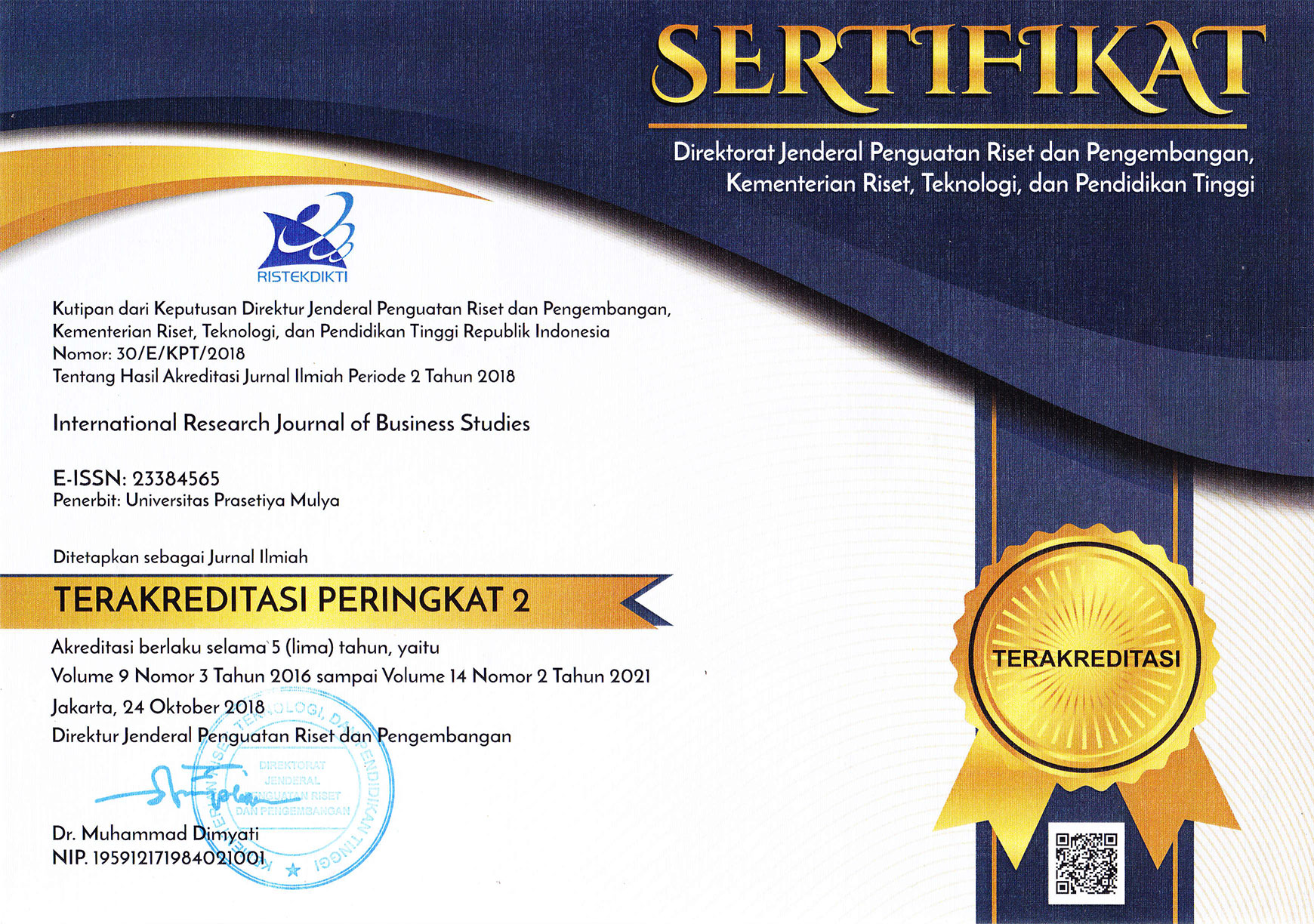The Influence of Brand Orientation to Donation Intention with Attitude Toward Charity as Mediator
DOI:
https://doi.org/10.21632/irjbs.17.3.267-280Keywords:
Brand Orientation, Donation Intention, Attitude Toward Charity , Non-Profit OrganizationAbstract
This study aims to investigate the impact of brand orientation's dimensions (orchestration, interaction, and affect) on attitudes towards charity and donation intentions. Additionally, it explores whether attitudes towards charity mediate the relationship between orchestration, interaction, affect, and donation intentions. The sample consists of Indonesian residents who have interacted with and/or donated to non-profit organizations in Indonesia. Purposive sampling was used, resulting in a sample size of 282 participants. The data analysis method employed is Structural Equation Modeling (SEM) with Partial Least Squares (PLS) measurements. The research achieved a confidence level of 95%. Findings indicate that the Orchestration dimension has no direct or indirect influence on donation intentions through attitudes towards charity. However, both the Interaction and Affect dimensions directly and indirectly influence donation intentions, with attitudes towards charity serving as a mediator. The mediation effect obtained is weak so that the mediation that occurs is partial mediation.References
Abzari, M., Ghassemi, R. A., & Vosta, L. N. (2014). Analysing the Effect of Social Media on Brand Attitude and Purchase Intention: The Case of Iran Khodro Company. Procedia - Social and Behavioral Sciences, 143, 822–826. https://doi.org/10.1016/j.sbspro.2014.07.483
Aji, H. M., Albari, A., Muthohar, M., Sumadi, S., Sigit, M., Muslichah, I., & Hidayat, A. (2021). Investigating the determinants of online infaq intention during the COVID-19 pandemic: An insight from Indonesia. Journal of Islamic Accounting and Business Research, 12(1), 1–20. https://doi.org/10.1108/JIABR-05-2020-0136
Ajzen, I. (n.d.). The Theory of Planned Behavior.
Apaydin, F. (2011). A proposed model of antecedents and outcomes of brand orientation for nonprofit sector. Asian Social Science, 7(9), 194–202. https://doi.org/10.5539/ass.v7n9p194
Barone, M. J., Norman, A. T., & Miyazaki, A. D. (2007). Consumer response to retailer use of cause-related marketing: Is more fit better? Journal of Retailing, 83(4), 437–445. https://doi.org/10.1016/j.jretai.2007.03.006
Beldad, A., Snip, B., & van Hoof, J. (2014). Generosity the Second Time Around: Determinants of Individuals’ Repeat Donation Intention. Nonprofit and Voluntary Sector Quarterly, 43(1), 144–163. https://doi.org/10.1177/0899764012457466
Chad, P. (2013). Implementing market orientation in charities: A necessity for survival. Marketing Theory, 13(3), 303–322. https://doi.org/10.1177/1470593113484921
da Silva, L. C., Mainardes, E. W., Teixeira, A. M. C., & Costa Júnior, L. (2020). Brand orientation of nonprofit organizations and its relationship with the attitude toward charity and donation intention. International Review on Public and Nonprofit Marketing, 17(3), 353–373. https://doi.org/10.1007/s12208-020-00251-6
do Paço, A. (2014). Branding in ngos – its influence on the intention to donate. Economics and Sociology, 7(3), 11–21. https://doi.org/10.14254/2071-789X.2014/7-3/1
Ellen, P. S., Webb, D. J., & Mohr, L. A. (2006). Building corporate associations: Consumer attributions for corporate socially responsible programs. Journal of the Academy of Marketing Science, 34(2), 147–157. https://doi.org/10.1177/0092070305284976
Ewing, M. T., & Napoli, J. (2005). Developing and validating a multidimensional nonprofit brand orientation scale. Journal of Business Research, 58(6), 841–853. https://doi.org/10.1016/j.jbusres.2003.09.012
Hair, J. F., Risher, J. J., Sarstedt, M., & Ringle, C. M. (2019). When to use and how to report the results of PLS-SEM. European Business Review, 31(1), 2–24. https://doi.org/10.1108/EBR-11-2018-0203
Hair, J. F., Sarstedt, M., Hopkins, L., & Kuppelwieser, V. G. (2014). Partial least squares structural equation modeling (PLS-SEM): An emerging tool in business research. European Business Review, 26(2), 106–121. https://doi.org/10.1108/EBR-10-2013-0128
Hankinson, P. (2001). Brand orientation in the Top 500 fundraising charities in the UK. Journal of Product & Brand Management, 10(6), 346–360. https://doi.org/10.1108/10610420110406040
Hassan, S. H., Masron, T. A., Noor, M., & Ramayah, T. (2018). Antecedents of trust towards the attitude of charitable organisation in monetary philanthropic donation among generation-Y. Asian Academy of Management Journal, 23(1), 53–78. https://doi.org/10.21315/aamj2018.23.1.3
Hsu, J. L., Liang, G. Y., & Tien, C. P. (2005). Social concerns and willingness to support charities. Social Behavior and Personality, 33(2), 189–200. https://doi.org/10.2224/sbp.2005.33.2.189
Koschate-Fischer, N., Stefan, I. V., & Hoyer, W. D. (2012). Willingness to Pay for Cause-Related Marketing: The Impact of Donation Amount and Moderating Effects. Journal of Marketing Research, XLIX, 1547–7193.
Lee, D. S. M., & Markham, P. A. (2006). Title Fundraising-related market orientation among non-profit organisations in Hong Kong: A literature review and research agenda.
Lee, Z. (2013). Rebranding in brand-oriented organisations: Exploring tensions in the nonprofit sector. Journal of Marketing Management, 29(9–10), 1124–1142. https://doi.org/10.1080/0267257X.2013.812978
Liu, G., Chapleo, C., Ko, W. W., & Ngugi, I. K. (2015). The Role of Internal Branding in Nonprofit Brand Management: An Empirical Investigation. Nonprofit and Voluntary Sector Quarterly, 44(2), 319–339. https://doi.org/10.1177/0899764013511303
Lwin, M., & Phau, I. (2014). An exploratory study of existential guilt appeals in charitable advertisements. Journal of Marketing Management, 30(13–14), 1467–1485. https://doi.org/10.1080/0267257X.2014.939215
Michel, G., & Rieunier, S. (2012). Nonprofit brand image and typicality influences on charitable giving. Journal of Business Research, 65(5), 701–707. https://doi.org/10.1016/j.jbusres.2011.04.002
Napoli, J. (2006). The Impact of Nonprofit Brand Orientation on Organisational Performance. Journal of Marketing Management, 22(7–8), 673–694. https://doi.org/10.1362/026725706778612176
Pope, J. A., Isely, E. S., & Asamoa-Tutu, F. (2009). Developing a marketing strategy for nonprofit organizations: An exploratory study. Journal of Nonprofit and Public Sector Marketing, 21(2), 184–201. https://doi.org/10.1080/10495140802529532
Ranganathan, S. K., & Henley, W. H. (2008). Determinants of charitable donation intentions: A structural equation model. International Journal of Nonprofit and Voluntary Sector Marketing, 13(1), 1–11. https://doi.org/10.1002/nvsm.297
Russell, D. W., & Russell, C. A. (2010). Here or there? Consumer reactions to corporate social responsibility initiatives: Egocentric tendencies and their moderators. Marketing Letters, 21(1), 65–81. https://doi.org/10.1007/s11002-009-9082-5
Song, D., & Kim, D. H. (2020). “I’ll donate money today and time tomorrow”: The moderating role of attitude toward nonprofit organizations on donation intention. International Journal of Nonprofit and Voluntary Sector Marketing, 25(3). https://doi.org/10.1002/nvsm.1659
Teah, M., Lwin, M., & Cheah, I. (2014). Moderating role of religious beliefs on attitudes towards charities and motivation to donate. Asia Pacific Journal of Marketing and Logistics, 26(5), 738–760. https://doi.org/10.1108/APJML-09-2014-0141
Vidyanata, D., Sunaryo, S., & Hadiwidjojo, D. (2018). THE ROLE OF BRAND ATTITUDE AND BRAND CREDIBILITY AS A MEDIATOR OF THE CELEBRITY ENDORSEMENT STRATEGY TO GENERATE PURCHASE INTENTION. JURNAL APLIKASI MANAJEMEN, 16(3), 402–411. https://doi.org/10.21776/ub.jam.2018.016.03.04
Wang, Y., po lo, H., Chi, R., & Yang, Y. (2004). An integrated framework for customer value and customer-relationship-management performance: A customer-based perspective from China. Managing Service Quality: An International Journal, 14, 169–182. https://doi.org/10.1108/09604520410528590
Wu, Y. L., Lin, T. W., & Wang, S. S. C. (2019). How Do Volunteer’s Experiences of Organizational Facilitators Influence Their Satisfaction and Loyalty: An Example of Hospital Volunteers. Voluntas, 30(5), 1104–1117. https://doi.org/10.1007/s11266-019-00096-6
Downloads
Submitted
Accepted
Published
How to Cite
Issue
Section
License
Copyright (c) 2024 Ramayanti Ramayanti, Pepey Riawati Kurnia, Anggun Pesona Intan (Author)

This work is licensed under a Creative Commons Attribution-ShareAlike 4.0 International License.
Journal Author(s) Rights
For IRJBS to publish and disseminate research articles, we need publishing rights (transferred from the author(s) to the publisher). This is determined by a publishing agreement between the Author(s) and IRJBS. This agreement deals with the transfer or license of the copyright of publishing to IRJBS, while Authors still retain significant rights to use and share their own published articles. IRJBS supports the need for authors to share, disseminate and maximize the impact of their research and these rights, in any databases.
As a journal Author, you have rights to many uses of your article, including use by your employing institute or company. These Author rights can be exercised without the need to obtain specific permission. Authors publishing in IRJBS journals have comprehensive rights to use their works for teaching and scholarly purposes without needing to seek permission, including:
- use for classroom teaching by Author or Author's institution and presentation at a meeting or conference and distributing copies to attendees;
- use for internal training by the author's company;
- distribution to colleagues for their research use;
- use in a subsequent compilation of the author's works;
- inclusion in a thesis or dissertation;
- reuse of portions or extracts from the article in other works (with full acknowledgment of the final article);
- preparation of derivative works (other than commercial purposes) (with full acknowledgment of the final article);
- voluntary posting on open websites operated by the author or the author’s institution for scholarly purposes,
(But it should follow the open access license of Creative Common CC-by-SA License).
Authors/Readers/Third Parties can copy and redistribute the material in any medium or format, as well as remix, transform, and build upon the material for any purpose, even commercially. Still, they must give appropriate credit (the name of the creator and attribution parties (authors' detail information), a copyright notice, an open access license notice, a disclaimer notice, and a link to the material), provide a link to the license, and indicate if changes were made (Publisher indicates the modification of the material (if any) and retain an indication of previous modifications.
Authors/Readers/Third Parties can read, print and download, redistribute or republish the article (e.g. display in a repository), translate the article, download for text and data mining purposes, reuse portions or extracts from the article in other works, sell or re-use for commercial purposes, remix, transform, or build upon the material, they must distribute their contributions under the same license as the original Creative Commons Attribution-ShareAlike (CC BY-SA).
This work is licensed under a Creative Commons Attribution-ShareAlike 4.0 International License.








